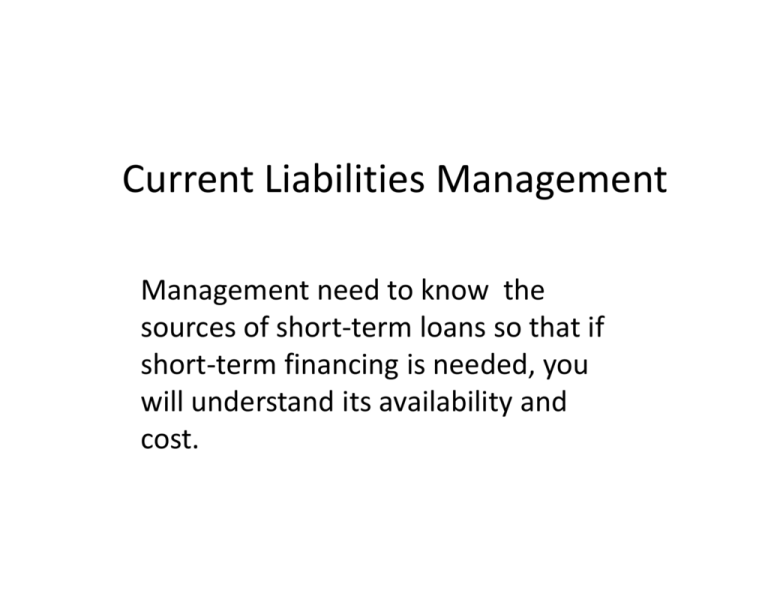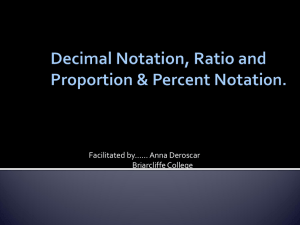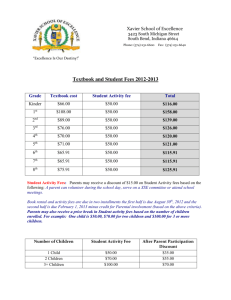Current Liabilities Management
advertisement

Current Liabilities Management Management need to know the sources of short-term loans so that if short-term financing is needed, you will understand its availability and cost. Spontaneous liabilities • Spontaneous liabilities arise from the normal course of business. • The two major spontaneous liability sources : accounts payable and accruals. • As a firm’s sales increase, accounts payable and accruals increase in response to the increased purchases, wages, and taxes. • There is normally no explicit cost attached to either of these current liabilities. Accounts Payable Management • Accounts payable are the major source of unsecured short-term financing for business firms. • The firm’s goal is to pay as slowly as possible without damaging its credit rating. Analyzing Credit Terms • Credit terms offered by suppliers allow a firm to delay payment for its purchases. • However, the supplier probably imputes the cost of offering terms in its selling price. • Therefore, the firm should analyze credit terms to determine its best credit strategy. • If a cash discount is offered, the firm has two options: to take the cash discount or to give it up. Taking the Cash Discount If a firm intends to take a cash discount, it should pay on the last day of the discount period. Lawrence Industries purchased $1,000 worth of merchandise on February 27 from a supplier extending terms of 2/10 net 30 EOM. If the firm takes the cash discount, it will have to pay $980 [$1,000 - (2% x $1,000)] on March 10th, saving $20. Giving Up the Cash Discount If a firm chooses to give up the cash discount, it should pay on the final day of the credit period. If Lawrence gives up the cash discount, payment can be made on March 30th. To keep its money for an extra 20 days, the firm must give up an opportunity to pay $980 for its $1,000 purchase, thus costing $20 for an extra 20 days. Cost = 2% x 100% - 2% 365 = 37.24% 30 - 10 The preceding example suggest that the firm should take the cash discount as long as it can borrow from other sources for less than 37.24%. Because nearly all firms can borrow for less than this (even using credit cards!?) they should always take the terms 2/10 net 30. Using the Cost of Giving Up the Cash Discount Mason Products has four possible suppliers, each offering different credit terms. Table 15.1 on the following slide presents the credit terms offered by its suppliers and the cost of giving up the cash discount in each transaction. If the firm needs short-term funds, which it can borrow from its bank at 13%, and if each of the suppliers is viewed separately, which (if any) of the suppliers discounts should the firm give up? Approximate cost of giving up cash discount: CD x 365 N Table 15.1 Effects of Stretching Accounts Payable • Stretching accounts payable simply involves paying bills as late as possible without damaging credit rating. • This can reduce the cost of giving up the discount. Lawrence Industries was extended credit terms of 2/10 net 30 EOM. The cost of giving up the cash discount is 36.5%. If Lawrence were able to stretch its accounts payable to 70 days without damaging its credit rating, the cost of giving up the cash discount would fall from 36.5% to only 12.2% [2% x (365/60)]. Three main sources of short-term funds: 1. Trade credits, borrowing form suppliers 2. Bank loans, borrowing form banks 3. Commercial paper, selling short-term debt securities in the open market Unsecured Sources of Short-Term Loans: Bank Loans • The major type of loan made by banks to businesses is the short-term, self-liquidating loan which are intended to carry firms through seasonal peaks in financing needs. • These loans are generally obtained as companies build up inventory and experience growth in accounts receivable. • As receivables and inventories are converted into cash, the loans are then retired. • These loans come in three basic forms: singlepayment notes, lines of credit, and revolving credit agreements. Loan Interest Rates – Most banks loans are based on the prime rate of interest which is the lowest rate of interest charged by the nation’s leading banks on loans to their most reliable business borrowers. – Banks generally determine the rate to be charged to various borrowers by adding a premium to the prime rate to adjust it for the borrowers “riskiness.” Fixed & Floating-Rate Loans – On a fixed-rate loan, the rate of interest is determined at a set increment above the prime rate and remains at that rate until maturity. – On a floating-rate loan, the increment above the prime rate is initially established and is then allowed to ‘float’ or vary with prime until maturity. Method of Computing Interest – Once the nominal (stated) rate of interest is established, the method of computing interest is determined. – Interest can be paid either when a loan matures or in advance. – If interest is paid at maturity, the effective (true) rate of interest—assuming the loan is outstanding for exactly one year—may be computed as follows: Interests Amount borrowed – If the interest is paid in advance, it is deducted from the loan so that the borrower actually receives less money than requested. – Loans of this type are called discount loans. The effective rate of interest on a discount loan assuming it is outstanding for exactly one year may be computed as follows: Interest Amount borrowed - Interest Example: Booster Company, a manufacturer of athletic apparel, wants to borrow $10,000 at a stated rate of 10% for 1 year. If interest is paid at maturity, the effective interest rate may be computed as follows: (10% X $10,000) = 10.0% $10,000 Booster Company, a manufacturer of athletic apparel, wants to borrow $10,000 at a stated rate of 10% for 1 year. If interest is paid at maturity, the effective interest rate may be computed as follows: If this loan were a discount loan, the effective rate of interest would be: (10% X $10,000) = 11.1% $10,000 - $1,000 Single Payment Notes – A single-payment note is a short-term, one-time loan payable as a single amount at its maturity. – The “note” states the terms of the loan, which include the length of the loan as well as the interest rate. – Most have maturities of 30 days to 9 or more months. – The interest is usually tied to prime and may be either fixed or floating. During the 90 days that loan B was outstanding, the prime rate was 6% for the first 30 days, 6.5% for the next 30 days, and 6.25% for the final 30 days. As a result, the periodic rate was .575% [7% x (30/365)] for the first 30 days, .616% for the second 30 days, and .596% for the final 30 days. Therefore, its total interest cost was $1,787 [$100,000 x (.575% + .616% + .596%)]. Thus, the effective cost is 1.787% for 90 days. The effective annual rate may be calculated as follows: EAR = (1 + periodic rate)m - 1 = (1+.01787)4.06 - 1 = 7.46% Terms of Sale Terms of Sale - periode kredit, potongan tunai, periode potongan tunai serta penentuan awal periode kredit. Periode kredit: jumlah hari mulai dari saat penentuan awal periode kredit sampai dengan saat pembayaran keseluruhan jumlah hutang. Example - 5/10 net 30 5 - percent discount for early payment 10 - number of days that the discount is available net 30 - number of days before payment is due APR & APY • Annual percentage rate (APR). The periodic rate times the number of periods in a year. For example: 2% per quarter is an 8% APR • Annual percentage yield (APY). The effective (true) annual rate of return. The APY is the rate you actually earn or pay in one year, taking into account the effect of compounding. For axample: 1% per month is a 12,68% APY. • A firm that buys on credit is in effect borrowing from its supplier. It saves cash today but will have to pay later. This, of course, is an implicit loan from the supplier. • We can calculate the implicit cost of this loan Effective annual rate ( = 1+ 365/ extra days credit ) discount discounted price -1 Example - On a $100 sale, with terms 5/10 net 60, what is the implied interest rate on the credit given? Effective annual rate ( discount = 1 + discounted price = (1 + ) 5 365/50 95 ) 365/extra days credit -1 - 1 = .454, or 45.4% Penentuan awal periode kredit: • The date of invoice • The end of the month (EOM) • The middle of the month (MOM) • On receipt of goods Contoh: • Persyaratan kredit 2/10 net 30. Pembelian dilakukan tanggal 10 dan 20 September. • Berikut ini tanggal yang harus dilakukan untuk pembelian 10 September pada berbagai penentuan awal periode kredit Awal Cash No cash kredit discount discount Date of 20 Sept invoice 10 Okt EOM 30 Okt 10 Okt MOM 25 Sept 15 Okt Berikut ini tanggal yang harus dilakukan untuk pembelian 20 September pada berbagai penentuan awal periode kredit Awal kredit Date of invoice Cash No discount Cash discount 30 Sept 20 Okt EOM 10 Okt 30 Okt MOM 25 Okt 15 Nop Cash discount vs No cash discount Pada 27 Maret membeli barang seharga Rp 1.000.000,00 dengan syarat kredit 2/10 net 30 EOM. • Cash discount. Pembayaran sebelum 10 April sebesar Rp 980.000,00 • No Cash discount . Pembayaran 30 April sebesar Rp 1.000.000,00







